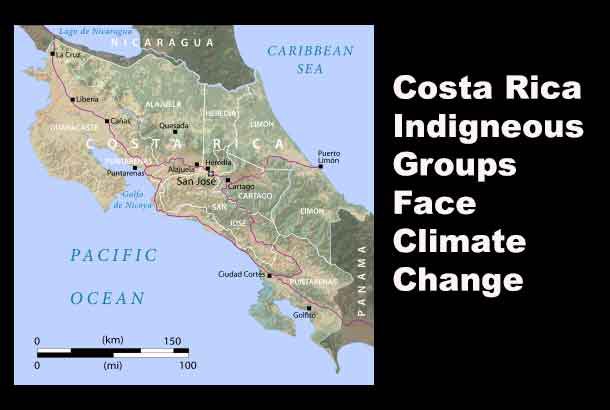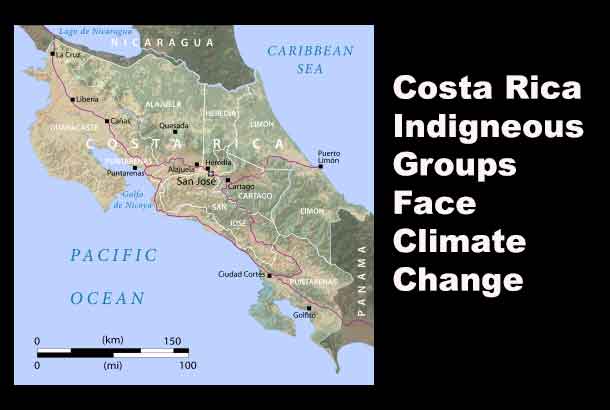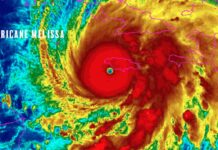
With international cash to adapt to climate change hard to access, Central American indigenous groups are moving to build their own supply
By Sebastian Rodriguez
SAN JOSE – (Thomson Reuters Foundation) – Leví Sucre, an indigenous leader from the Bribri community in Costa Rica, remembers how his family used to grow beans on 5 or 6 hectares of land at their home in the Talamanca region. But that was many years ago, he says.
“That’s impossible now. When growing beans, there’s a period where they can’t receive water (and need dry conditions). Now, unexpected cold fronts and rains are spoiling them” he told the Thomson Reuters Foundation.
Serious Impact on Food Security from Climate Change
According to Sucre, climate change is having serious impacts on the food security of indigenous communities. But they’re not able to adapt fast enough, since access to international climate funds to provide cash for needed changes is, as he puts it, “an almost impossible task”.
“We have too many limitations and they ask for too many things; starting with understanding how these things even work in the first place. In the end, the funds are created but never really reach us,” said the indigenous leader in an interview.
Getting climate finance to the places where it is needed most – particularly communities trying to adapt to climate change impacts such as more unpredictable and extreme weather – is a huge challenge.
International climate funds, trying to ensure the money is well spent, require extensive paperwork – something beyond the abilities of many poor communities, their members say.
Funds usually also prefer to make a few large-scale grants or loans rather than thousands of small ones, in an effort to speed the distribution of money and avoid the time involved in vetting many small projects, experts say.
The Green Climate Fund (GCF), created in 2010 by the United Nations to finance mitigation and adaptation projects, has faced criticism because of how difficult it can be for countries and local communities to get accredited and access the money.
Andrea Meza, climate change director for Costa Rica’s Ministry of Environment, told the Thomson Reuters Foundation that accessing these funds tends to be a draining process for indigenous communities.
“It’s possible that they want to start projects with development banks or NGOs but it’s clear that accessing these funds is not a fast, short, cheap or easy process,” Meza said.
Between 2003 and 2015, only about 11 percent of $1.6 billion in climate finance flows reached local communities, according to research by the London-based International Institute for Environment and Development (IIED).
That was despite communities taking some of the most effective action to tackle climate change, experts say.
“They’re the ones that are living in these environments on a day-to-day basis. They understand what interventions are going to make the most impact,” Marek Soanes, a climate finance researcher at IIED, said during last November’s U.N. climate talks in Bonn.

BY THE PEOPLE, FOR THE PEOPLE
But after struggling with a lack of access to international climate funding, Sucre and other indigenous leaders from Central America and Mexico have come up with a solution: They are trying to create their own climate fund.
With their regional organization, the Mesoamerican Alliance of People and Forests, they are assembling a “Mesoamerican Territorial Fund”, which they hope could receive international funding.
The initiative aims to give rapid and easy financing to indigenous communities so they can implement climate change adaptation and mitigation projects.
One of the key aspects of the fund is that it will be managed by indigenous people and benefit their own communities, with little input from outsiders, Sucre said – though the Central American Bank for Economic Integration would hold the money.
“We are trying to install this initiative in the Central American Bank for Economic Integration because they can meet the necessary requirements. However, the money would be politically administered by the territories, not by them,” the Bribri leader said.
The fund would finance projects that communities themselves propose and want to develop, he said, in an effort to avoid projects being imposed from outside, and to meet the different needs of each community.
That’s important because, in the past, foreign investment in indigenous communities has sparked tensions among the groups, indigenous leader Magaly Lázaro told the Thomson Reuters Foundation.
In particular, REDD+ – an effort to improve forest protection by giving communities living in forests incentives to protect them – “has provoked tensions in the relationship between communities”, she said.
“There’s been an inclusive process in certain territories but that hasn’t been the case for ours in Buenos Aires and the rest of the Southern region,” she said.
Her indigenous group ended up protesting against REDD+ (Reducing Emissions from Deforestation and Forest Degradation) efforts in their region, saying they imposed an alien form of conservation and created community conflicts.
The Mesoamerican Territorial Fund hopes to avoid such problems, Sucre said. He said he hoped funding could begin to flow into the fund as early as this year.
“We hope that by mid-2018 we already have the fund technically designed and ready to apply for international funds. By the second semester we hope to start financing,” he said.
CLIMATE PRESSURES
The impact of climate change on indigenous territories is significant, Sucre said. Worsening natural disasters and weakening food security are some of the most threatening issues that indigenous communities face, he said.
U.N. research concurs that “indigenous peoples are among the first to face the direct consequences of climate change, owing to their dependence upon, and close relationship with the environment and its resources”, according to a 2008 report.
Sucre said indigenous communities need to change the way they farm their land in response to increasingly unstable weather.
Because of increasing harvest losses, he said, many communities are growing more dependent on supermarkets.
But with worsening storms blocking roads and cutting off access to indigenous territories, that dependence could leave people without food in emergencies, Magaly Lázaro said.
Last October for example, Hurricane Nate left many indigenous communities in the Southern region of Costa Rica isolated after the collapse of many main road routes.
According to government data, the country’s Aerial Surveillance Service had to transport 13,5 tons of food to the region by helicopter.
“We don’t want to depend on any external entities. We want to depend on our own way of working,” Lázaro said.
The Mesoamerican Territorial Fund, Sucre said, will aim to finance adaptation projects that protect the food security of indigenous territories, in part using the traditional knowledge they have acquired through the years.
“We’re not dismissing the use of technology because we know that it must be complementary. But we want to incentivize the use of technologies that don’t erase our culture,” the indigenous leader said.
(Reporting by Sebastian Rodriguez ; editing by Laurie Goering : The Thomson Reuters Foundation







